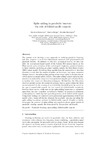Spike-adding in parabolic bursters : The role of folded-saddle canards
| dc.contributor.author | Desroches, M | |
| dc.contributor.author | Krupa, M | |
| dc.contributor.author | Rodrigues, S | |
| dc.date.accessioned | 2016-06-05T08:07:57Z | |
| dc.date.accessioned | 2016-06-05T08:32:37Z | |
| dc.date.available | 2016-06-05T08:07:57Z | |
| dc.date.available | 2016-06-05T08:32:37Z | |
| dc.date.issued | 2016-09-15 | |
| dc.identifier.issn | 0167-2789 | |
| dc.identifier.issn | 1872-8022 | |
| dc.identifier.uri | http://hdl.handle.net/10026.1/4835 | |
| dc.description.abstract |
The present work develops a new approach to studying parabolic bursting, and also proposes a novel four-dimensional canonical and polynomial-based parabolic burster. In addition to this new polynomial system, we also consider the conductance-based model of the Aplysia R15 neuron known as the Plant model, and a reduction of this prototypical biophysical parabolic burster to three variables, including one phase variable, namely the Baer–Rinzel–Carillo (BRC) phase model. Revisiting these models from the perspective of slow–fast dynamics reveals that the number of spikes per burst may vary upon parameter changes, however the spike-adding process occurs in an explosive fashion that involves special solutions called canards. This spike-adding canard explosion phenomenon is analysed by using tools from geometric singular perturbation theory in tandem with numerical bifurcation techniques. We find that the bifurcation structure persists across all considered systems, that is, spikes within the burst are incremented via the crossing of an excitability threshold given by a particular type of canard orbit, namely the true canard of a folded-saddle singularity. However there can be a difference in the spike-adding transitions in parameter space from one case to another, according to whether the process is continuous or discontinuous, which depends upon the geometry of the folded-saddle canard. Using these findings, we construct a new polynomial approximation of the Plant model, which retains all the key elements for parabolic bursting, including the spike-adding transitions mediated by folded-saddle canards. Finally, we briefly investigate the presence of spike-adding via canards in planar phase models of parabolic bursting, namely the theta model by Ermentrout and Kopell. | |
| dc.format.extent | 58-70 | |
| dc.language | en | |
| dc.language.iso | en | |
| dc.publisher | Elsevier BV | |
| dc.relation.replaces | http://hdl.handle.net/10026.1/4831 | |
| dc.relation.replaces | 10026.1/4831 | |
| dc.subject | Parabolic bursting | |
| dc.subject | Spike-adding | |
| dc.subject | Folded-saddle canards | |
| dc.title | Spike-adding in parabolic bursters : The role of folded-saddle canards | |
| dc.type | journal-article | |
| dc.type | Journal Article | |
| plymouth.author-url | https://www.webofscience.com/api/gateway?GWVersion=2&SrcApp=PARTNER_APP&SrcAuth=LinksAMR&KeyUT=WOS:000380629900005&DestLinkType=FullRecord&DestApp=ALL_WOS&UsrCustomerID=11bb513d99f797142bcfeffcc58ea008 | |
| plymouth.volume | 331 | |
| plymouth.publication-status | Published | |
| plymouth.journal | Physica D | |
| dc.identifier.doi | 10.1016/j.physd.2016.05.011 | |
| plymouth.organisational-group | /Plymouth | |
| plymouth.organisational-group | /Plymouth/Faculty of Science and Engineering | |
| dc.contributor.advisor | ||
| dcterms.dateAccepted | 2016-05-23 | |
| dc.rights.embargodate | 2017-5-31 | |
| dc.identifier.eissn | 1872-8022 | |
| dc.rights.embargoperiod | Not known | |
| rioxxterms.versionofrecord | 10.1016/j.physd.2016.05.011 | |
| rioxxterms.licenseref.uri | http://www.rioxx.net/licenses/all-rights-reserved | |
| rioxxterms.licenseref.startdate | 2016-09-15 | |
| rioxxterms.type | Journal Article/Review |


